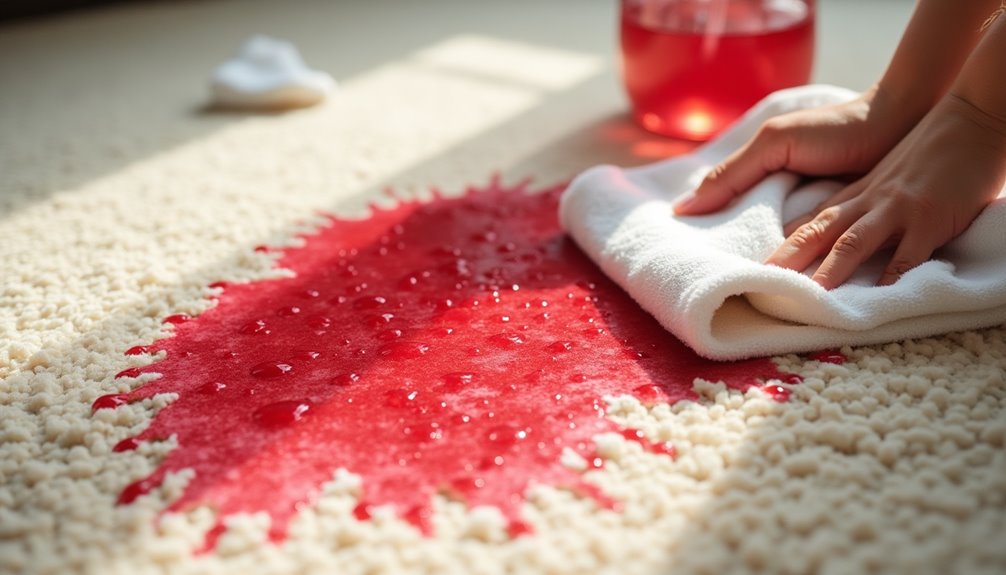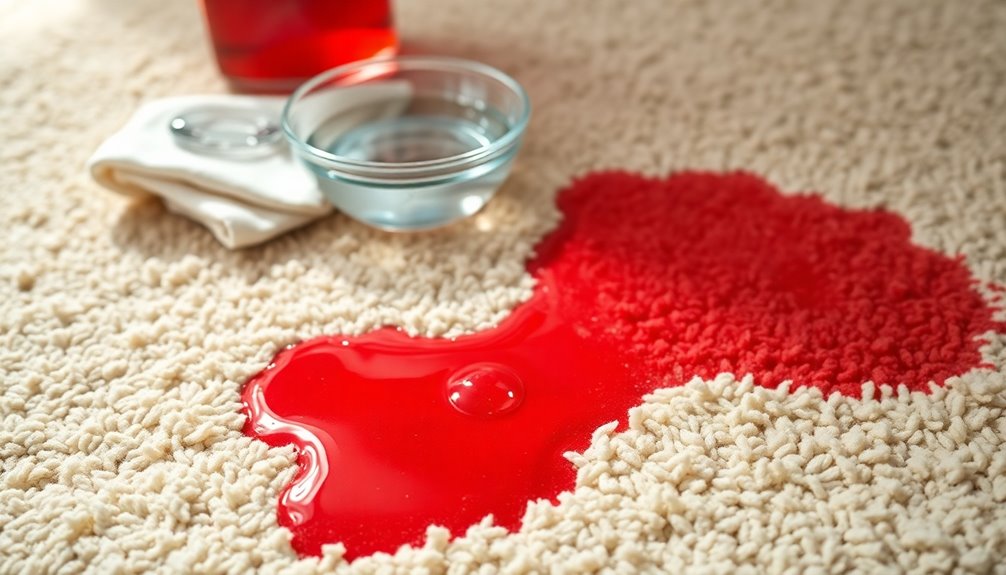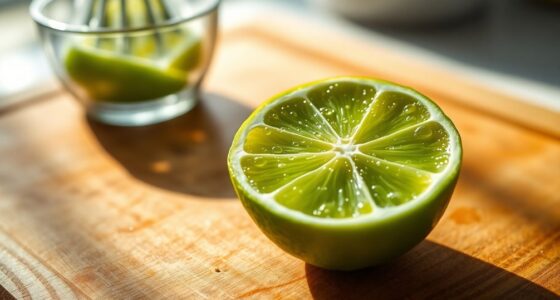If you spill juice on your carpet, act fast! Blot the stain to absorb as much liquid as you can. Then, mix one tablespoon of dish soap with two cups of warm water, applying it gently with a sponge. If the stain persists, try a mixture of ½ cup white vinegar and 2/3 cup water, letting it sit before rinsing. For lingering stains, use hydrogen peroxide. Keep going, and you'll discover even more effective methods!
Key Takeaways
- Blot the juice stain immediately with a clean cloth to absorb excess liquid without rubbing.
- Prepare a cleaning solution of one tablespoon dish soap mixed with two cups warm water to treat the stain.
- For stubborn stains, apply a mixture of ½ cup white vinegar and 2/3 cup water directly to the area and let it sit.
- Use 3% hydrogen peroxide on remaining stains, cover with paper towels, and place a weight on top for about an hour.
- Be patient and repeat cleaning steps as needed; regular maintenance improves stain removal effectiveness.

When you spill juice on your carpet, acting quickly can make all the difference in getting that stain out. The first step is to immediately blot the stain with a clean cloth or paper towel. This helps absorb as much liquid as possible, and the sooner you do this, the better your chances are of removing the juice stain completely. Avoid rubbing the stained area, as this can push the juice deeper into the carpet fibers, making it harder to clean.
Once you've blotted the stain, it's time to prepare a cleaning solution. Mix a tablespoon of dishwashing liquid with two cups of warm water. With a sponge, gently work this solution into the stained area. Be careful not to soak the carpet; you just want to dampen it enough to lift the stain. After you've worked in the solution, continue to blot the stain with a clean cloth. You should see some improvement, but if the stain persists, don't worry—there are more options available.
For those stubborn juice stains that just won't budge, you might want to try a mixture of 2/3 cup water and ½ cup white vinegar. Apply this directly to the stained area and let it sit for a few minutes. The acidity of the vinegar can help break down the stain. After waiting, rinse the area with water and again, blot dry with a clean cloth. This should help in removing the juice and refreshing the carpet.
If you still see remnants of the stain, consider using 3% hydrogen peroxide. Moisten the stained area with it, then cover it with dry paper towels and place a weight on top. Let it sit for about an hour. This method can be quite effective in lifting stubborn stains. Just remember, after the time is up, you'll need to rinse the treated area with cold water and blot dry again. This step is crucial to prevent any sticky residue or potential re-dyeing from the colored additives in the juice.
Throughout this process, patience is key. If the stain isn't coming out as quickly as you'd like, repeat the cleaning steps as necessary. Remember, regular carpet cleaning can also help maintain the appearance of your carpet and make future stain removal easier.
With the right approach and quick action, you can effectively remove juice stains from your carpet and keep it looking fresh. Don't let one spill ruin your day—armed with these cleaning tips, you're ready to tackle any juice mishap!
Frequently Asked Questions
How Do You Get Dried Juice Stains Out of Carpet?
To tackle dried juice stains on your carpet, start by moistening the area with lukewarm water to loosen the residue.
Mix 2/3 cup water with ½ cup white vinegar, spray it on the stain, and let it sit for 5-10 minutes.
For tougher stains, try a 3% hydrogen peroxide solution.
Always blot after each treatment and repeat until the stain's gone.
Don't forget to test any solution on an inconspicuous spot first!
Does Juice Come Out of Carpet?
Imagine a vibrant splash of color on your carpet, like a painter's mistake.
Don't worry, juice can indeed come out! If you act quickly, you can lift that stain before it sets in.
Blot it gently with a clean cloth, and use a mix of white vinegar and warm water to target the stain.
Rinse the area with cold water afterward.
With persistence, your carpet can return to its original beauty, free of fruity mischief.
How Do You Remove Old Juice Stains?
To remove old juice stains, start by moistening the stained area with 3% hydrogen peroxide and let it sit for an hour. This helps break down the stain.
Next, mix dishwashing detergent with warm water, and gently blot the area to lift any remaining residue. Rinse thoroughly with cold water to eliminate any cleaning agents.
If the stain's still there, repeat the hydrogen peroxide treatment or try a vinegar solution for extra cleaning power.
How Do You Get Liquid Stains Out of Carpet?
When life gives you stains, you've got to act fast!
To get liquid stains out of your carpet, start by blotting the area immediately with a clean towel—don't rub, or you'll push it deeper.
Next, moisten the stain with lukewarm water to dilute it.
Mix a tablespoon of dish soap with two cups of warm water, apply it with a sponge, and blot until the stain lifts.
Finally, rinse and pat dry.
Conclusion
With these simple steps, you'll banish juice stains like a superhero vanquishing villains! Don't let those pesky stains take over your carpet kingdom. Armed with your cleaning supplies, you'll feel invincible as you wipe away every trace of that fruity disaster. Soon, your carpet will look so pristine, it'll be the envy of all your friends—who might even think you've got a secret carpet fairy! So, go on, unleash your inner cleaning champion and reclaim your space!
Cindy thoroughly researches juicing trends, techniques, and recipes to provide readers with practical advice and inspiration. Her writing style is accessible, engaging, and designed to make complex concepts easy to understand. Cindy’s dedication to promoting the advantages of juicing shines through her work, empowering readers to make positive changes in their lives through the simple act of juicing.

















